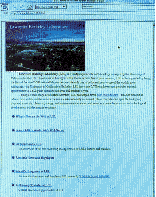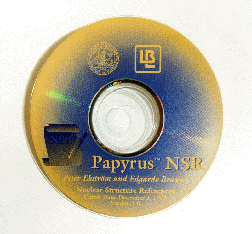

 LBL's World Wide Web home page is the index to an archive
of electronic
LBL's World Wide Web home page is the index to an archive
of electronic
information to which more than 100,000 visitors have logged on.
On the global computer network known as the World Wide Web, LBL was among the
first of what are now more than 10,000 organizations to create their own
on-line library of information. As with the World Wide Web itself, the number
of people using the Web at LBL is mushrooming. More than 100,000 visitors have
logged onto the Laboratory's home page, and during an average week some 12,000
files are retrieved by people all over the world.
News about LBL's research findings, including full text versions of Currents, the Lab's weekly newspaper, and Research Review, the quarterly magazine, can be accessed electronically via the Internet. Also accessible is a voluminous body of scientific reference material including information on life sciences, physics, chemistry and the materials sciences, energy and environmental sciences, and computing.
Anyone with access to the Internet can connect to LBL's home page using software such as Netscape, Mosaic, lynx, or gopher. The address or URL for LBL is href="http://www.lbl.gov/LBL.html"
 Not all computer work is done on-line, of course. CD-ROMs have become the
latest rage for users at home or on the job. To make life a little easier for
nuclear science researchers and students who need to do literature searches but
cannot access the on-line databases, collaborators at LBL and Lund University
in Sweden have developed a CD-ROM that holds the bibliographic data for every
important paper published on nuclear structure since 1910. From the early
studies by Ernest Rutherford, discoverer of the atomic nucleus, to recent
experiments on the transuranium elements at LBL and elsewhere, the CD-ROM,
which is called "Papyrus NSR," contains all the listings found in Nuclear
Structure References, the on-line physics database maintained at Brookhaven
National Laboratory. Papyrus NSR is distributed free through LBL's Isotopes
Project.
Not all computer work is done on-line, of course. CD-ROMs have become the
latest rage for users at home or on the job. To make life a little easier for
nuclear science researchers and students who need to do literature searches but
cannot access the on-line databases, collaborators at LBL and Lund University
in Sweden have developed a CD-ROM that holds the bibliographic data for every
important paper published on nuclear structure since 1910. From the early
studies by Ernest Rutherford, discoverer of the atomic nucleus, to recent
experiments on the transuranium elements at LBL and elsewhere, the CD-ROM,
which is called "Papyrus NSR," contains all the listings found in Nuclear
Structure References, the on-line physics database maintained at Brookhaven
National Laboratory. Papyrus NSR is distributed free through LBL's Isotopes
Project.

Return to the Table of Contents of the 1994 Regents Report
